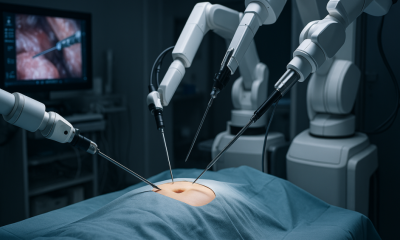Robotics
Fastest Soft Robots To-Date Developed by Researchers

A group of researchers has developed a new type of soft robot that is faster than previous versions when moving on solid surfaces or in the water. The new soft robots, which were inspired by the biomechanics of cheetahs, can also delicately pick up objects and have enough power to lift heavy objects.
The paper is titled “Leveraging elastic instabilities for amplified performance: Spine-inspired high-speed and high-force soft robots” and was published in the American Association for the Advancement of Science.
Jie Yin is an assistant professor of mechanical and aerospace engineering at North Carolina State University. He is also a corresponding author of the paper.
“Cheetahs are the fastest creatures on land, and they derive their speed and power from the flexing of their spines,” says Yin.
“We were inspired by the cheetah to create a type of soft robot that has a spring-powered, ‘bistable' spine, meaning that the robot has two stable states,” Yin continues. “We can switch between these stable states rapidly by pumping air into channels that line the soft, silicone robot. Switching between the two states releases a significant amount of energy, allowing the robot to quickly exert force against the ground. This enables the robot to gallop across the surface, meaning that its feet leave the ground.
“Previous soft robots were crawlers, remaining in contact with the ground at all times. This limits their speed.”
Previous Versions of Soft Robots
On flat and solid surfaces, the previous fastest soft robots were capable of moving at speeds of up to 0.8 body lengths per second.
The soft robots created by the group of researchers belongs to a brand new class of robots, called Leveraging Elastic Instabilities for Amplified Performance” (LEAP). They greatly outperform the previous ones, being able to move 2.7 body lengths per second, which is more than three times faster. They operate at a low actuation frequency of about 3Hz.
The new soft robots can also run up steep inclines, which has previously been a big challenge or even impossible for the lesser powerful ones.
The LEAP robots are about 7 centimeters long and weigh around 45 grams.
Swimming Speed
Another development with the new soft robots is that they have improved swimming speeds, which can be done by swapping out the feet for a fin. When doing this, the LEAP robot could reach a speed of 0.78 body lengths per second when swimming. The previous fastest swimming robot was only able to go 0.7 body lengths per second.
“We also demonstrated the use of several soft robots working together, like pincers, to grab objects,” Yin says. “By tuning the force exerted by the robots, we were able to lift objects as delicate as an egg, as well as objects weighing 10 kilograms or more.”
The group of researchers will aim to increase the speed and power of the robots even more, seeing the current development as just the beginning. They have various different applications in mind, such as search and rescue technologies.
“Potential applications include search and rescue technologies, where speed is essential, and industrial manufacturing robotics,” Yin says. “For example, imagine production line robotics that are faster, but still capable of handling fragile objects.
“We're open to collaborating with the private sector to fine-tune ways they can incorporate this technology into their operations.”
The work was supported by the National Science Foundation.











